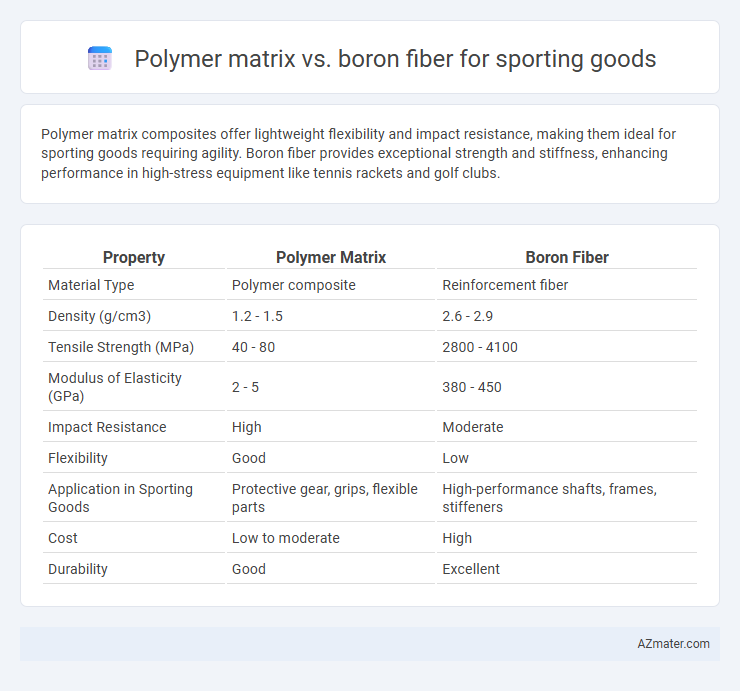Polymer matrix composites offer lightweight flexibility and impact resistance, making them ideal for sporting goods requiring agility. Boron fiber provides exceptional strength and stiffness, enhancing performance in high-stress equipment like tennis rackets and golf clubs.
Table of Comparison
| Property | Polymer Matrix | Boron Fiber |
|---|---|---|
| Material Type | Polymer composite | Reinforcement fiber |
| Density (g/cm3) | 1.2 - 1.5 | 2.6 - 2.9 |
| Tensile Strength (MPa) | 40 - 80 | 2800 - 4100 |
| Modulus of Elasticity (GPa) | 2 - 5 | 380 - 450 |
| Impact Resistance | High | Moderate |
| Flexibility | Good | Low |
| Application in Sporting Goods | Protective gear, grips, flexible parts | High-performance shafts, frames, stiffeners |
| Cost | Low to moderate | High |
| Durability | Good | Excellent |
Introduction to Composite Materials in Sporting Goods
Polymer matrix composites, widely used in sporting goods, offer a lightweight and durable structure that enhances performance and flexibility. Boron fiber composites provide exceptional stiffness and strength, making them ideal for high-performance equipment such as tennis rackets and golf clubs. The integration of these advanced materials revolutionizes sporting goods by improving impact resistance, weight reduction, and overall durability.
Overview of Polymer Matrix Composites
Polymer matrix composites (PMCs) in sporting goods combine lightweight thermosetting or thermoplastic polymers with reinforcing fibers to enhance strength, stiffness, and durability. These composites allow for tailored mechanical properties, impact resistance, and design flexibility, making them ideal for high-performance equipment such as tennis rackets, golf clubs, and bicycle frames. Compared to boron fiber composites, PMCs offer cost-effective manufacturing and improved corrosion resistance while maintaining competitive strength-to-weight ratios.
Understanding Boron Fiber Composites
Boron fiber composites offer superior stiffness-to-weight ratios compared to traditional polymer matrix materials, making them ideal for high-performance sporting goods like golf clubs and tennis rackets. The unique atomic structure of boron fibers enhances tensile strength and fatigue resistance within the composite, improving durability and impact resistance. Integrating boron fibers into polymer matrices results in lightweight sporting equipment with exceptional precision and control, outperforming conventional fiber-reinforced polymers.
Mechanical Properties: Polymer Matrix vs Boron Fiber
Boron fiber exhibits significantly higher tensile strength and stiffness compared to polymer matrix materials, making it ideal for high-performance sporting goods such as golf clubs and tennis rackets. Polymer matrices provide excellent impact resistance and flexibility, which enhances shock absorption and durability under repetitive loads. The combination of boron fibers with polymer matrices results in composite materials that leverage the high mechanical strength of boron and the toughness of polymers for optimized sporting equipment performance.
Weight and Density Comparison
Polymer matrix composites exhibit lower density, typically around 1.2-1.6 g/cm3, compared to boron fiber composites with densities approximately 2.6-2.7 g/cm3, making polymers advantageous for lightweight sporting goods. The weight reduction achieved with polymer matrix materials enhances performance by improving maneuverability and reducing user fatigue. Boron fiber, while denser, provides superior stiffness and strength, often preferred for high-impact applications despite its increased mass.
Durability and Impact Resistance
Polymer matrix composites offer enhanced impact resistance and flexibility, making them ideal for sporting goods requiring shock absorption and repeated stress endurance. Boron fiber materials provide exceptional durability and tensile strength, resulting in lightweight yet highly resilient equipment that withstands harsh conditions and heavy use. Combining polymer matrices with boron fibers often delivers superior performance by balancing toughness with stiffness, essential for high-performance sports gear.
Flexibility and Performance Benefits
Polymer matrix composites offer superior flexibility compared to boron fibers, enabling enhanced impact resistance and shock absorption in sporting goods. Boron fiber, however, excels in performance benefits by providing exceptional stiffness and tensile strength, ideal for high-performance applications like tennis racquets and golf club shafts. The combination of a polymer matrix with boron fiber creates lightweight, durable sporting equipment that maximizes both flexibility and performance.
Cost Implications and Manufacturing Processes
Polymer matrix composites offer lower material costs and simpler manufacturing processes compared to boron fiber, which requires expensive raw materials and specialized fabrication techniques. The polymer matrix enables mass production through molding and curing methods, reducing labor intensity and cycle times, whereas boron fiber reinforcement demands precision handling and lengthy integration, escalating overall expenses. Cost implications favor polymer matrices for large-scale sporting goods production, while boron fiber's higher strength-to-weight ratio justifies its premium in high-performance, niche applications.
Popular Applications in Sporting Equipment
Polymer matrix composites reinforced with boron fibers are widely used in high-performance sporting goods due to their exceptional strength-to-weight ratio and stiffness. Popular applications include tennis rackets, golf club shafts, and bicycle frames, where enhanced durability and responsiveness are critical for athlete performance. Boron fiber composites provide superior impact resistance and fatigue life, making them ideal for equipment subjected to repetitive stress and dynamic loads.
Future Trends and Innovations in Composite Sporting Goods
Polymer matrix composites dominate the sporting goods industry due to their lightweight and high-strength properties, with ongoing innovations targeting enhanced toughness and impact resistance through nanomaterial integration. Boron fiber composites are gaining attention for their exceptional stiffness-to-weight ratio, making them ideal for high-performance equipment like tennis rackets and golf clubs, where precision and durability are critical. Future trends emphasize hybrid composites combining polymer matrices with boron fibers to achieve superior performance, reduced manufacturing costs, and sustainability through recyclable materials in advanced sporting goods.

Infographic: Polymer matrix vs Boron fiber for Sporting good
 azmater.com
azmater.com